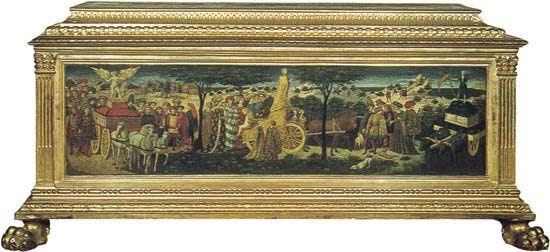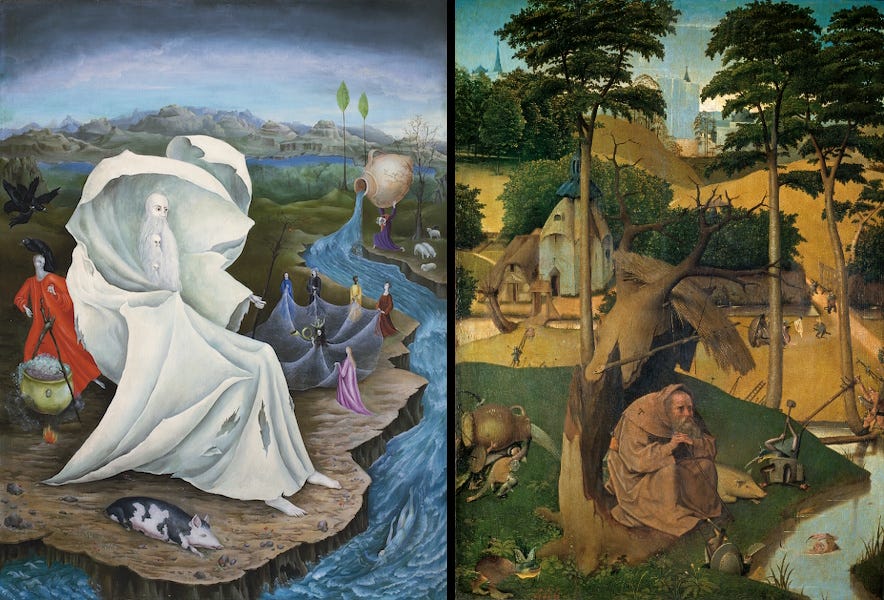Dear coven,
For this week’s enchantment I would like to talk to you about Leonora Carrington’s 1945 painting The House Opposite. For those new here, enchantment of the week is a weekly series in which I introduce you to painting, photography, literature, and various works of art that were motivated by magic. Let’s begin.
After narrowly escaping the possibility of being committed into yet another psychiatric hospital by her family, Leonora Carrington, along with a swarm of surrealists fleeing WWII, arrived in Mexico. Due to the generous policy for European war refuges established by President Lazaro Cardenas del Rio and his leftist government, Carrington was granted citizenship and asylum.
A fully-formed and liberated version of Carrington can be traced in her Mexican years paintings, filled with magical activities taking place in domestic spaces such as kitchens and gardens. Her artworks in Mexico present a world woven by fairy tales and legends, and her stories display a language of ancient familiarity drawn from fables, and invisible dimensions, intertwined with the world she lived in. The hybrid Catholicism in Mexico, which echoed the artist’s upbringing, the small group of emigrant Surrealists, the marketplaces and Carrington’s ever-growing interest in the occult are all key points of focus when analysing her Mexican works.
Rich with symbolic references and experimental in technique, The House Opposite (1945) showcases Carrington’s evolution after her departure to Mexico. This painting is stark in its iconographic complexity and it draws symbols from Self-Portrait, Down Below, as well as numerous stories and paintings within Carrington’s oeuvre.
Each corner of the painting provides insight not only into the introspection Carrington was undergoing, but the symbols and characters which can be encountered throughout her art and writing, accompanying her pictorial language like a witch’s familiars.
Before delving into each chamber of The House Opposite and its occupants, it is important to note the European influences on technique and composition. At the age of fifteen, Carrington was sent to a school for aristocratic children in Florence and while her parents’ goal was to teach her how to behave socially, Carrington partook in a different kind of education. Seeing the paintings of Uccello, Archimbaldo, Pisanello and exploring the work of Sienese artists such as Sassetta, Francesco di Giorgio and Giovanni de Paolo, contributed to her love of tempera painting. In addition to the trecento and Quattrocento paintings, according to Paul De Angelis, predella panels, as well as cassoni painted with moral fables and fairy tales were of special interest to Carrington.

Much like Uccello’s paintings , The House Opposite displays a multidimensional narrative in which the figures are interconnected, yet distant, each element grasping the observer’s attention and curiosity.
In Carrington’s painting the action takes place in a six-room house as the night sky peeks through at the top of the canvas. The figures appear to be female, most of who are engaged in preparation or consummation of food.
In the upper left corner the space is occupied by two figures, notably a woman resembling the Virgin Mary, dressed in blue, with a cat beneath her feet. The hybrid Catholicism prevalent in Carrington’s art is represented through this juxtaposition of a Christian symbol accompanied by a witches’ companion – the cat. Next to the Virgin Mary, a woman is crouched down on her knees in a hermit-like robe, staring at another figure which seems to be falling through a trap door leading her to the main room.
Within the small glimpse of the night sky above the house we can observe a star, the light of which peeks into the room, interestingly, the figure which is seen falling, appears to have a star-like shape at the split ends of her hair. It can be interpreted that this character signifies a falling star. The room that it stumbles into is the largest of the house with a dominating figure sitting in the middle of a long table. Knowing Carrington’s preoccupation with the Bible and her fascination with the gap and peculiarities within it, it’s not unsafe to assume that this could be a reference to the star of Bethlehem.
From the sky above, through the Virgin Mary’s path and into the main room, the falling star tumbles down the trap door, where the figure dressed in red and blue robes is served food and wine on a long empty table, resembling the Last Supper with no attendants other than Christ.
The House Opposite is one of the many, albeit subtle, references, to Christ and the Renaissance in Carrington’s works. A work that displays her profound knowledge and dedication in this area is The Temptation of St. Anthony (1947), one of her only works that directly tells a Biblical story.
During her travels through Spain in 1941 Carrington visited the Prado Museum in Madrid and was deeply impressed by the works of Hieronymus Bosch and Pieter Bruegel the Elder. Carrington’s paintings certainly had a vivid influence by Bosch’s artworks, swarmed with small figures engaged in curious and arcane activities.
Leonora Carrington recreated Bosch’s storytelling through her painting of St. Anthony as an entry to the Bel Ami International Art Competition. Naturally, many of the elements in her rendition are borrowed from Bosch such as the composition, the pig companion, the jump in scale and the extreme attention to detail.

Susan Aberth points out that while The Temptation of St. Anthony is not about women’s sacred domestic space, it is still about the survival and power of pre-Christian feminine spiritual practices.
Carrington’s childhood fascination with saints and miracles pours onto her canvas through her developing feminist consciousness. Much like in The House Opposite, in The Temptation of St Anthony a bubbling cauldron is present, a symbol of mysticism and alchemical transformation, while in the background witches’ rituals lurk behind the saint-like figure.
Returning to the main chamber in The House Opposite, upon closer inspection, the prominent figure sat at the table has a likeness to a horse with its muzzle missing from its physical form, yet present in the shadow cast on the wall. The horse-like character’s hand lingers above a bowl, indicating a sign of enchantment, an unoccupied chair, facing an empty plate sits at the end of the table, and beneath – three apparitions float from under the house and through the cracks.
The horse woman’s attention is directed towards a figure dressed in a red robe, her head is a deciduous tree and she is running in between the walls, behind her a river flows down a hill. The rogue tree-woman appears as if she has escaped the forest outside, bringing an offering to the house’s occupant.
Meanwhile, a girl emerges from the lower right corner seemingly running from the tunnel connected to the kitchen while carrying a bowl with a live hen as an offering. Carrington’s preoccupation with food preparation is present here, the tunnel linking the kitchen and the main room indicating the act of transformation.
While the preparation of food in Carrington’s work is akin to esoteric rituals, the consumption of it is tied to religion. For centuries, eating had been the most literal form of encounter with God, with women at the centre – sin entered the world when Eve ate the forbidden fruit, and salvation could only come when Christians eat their God in the ritual of communion.
Carrington’s portrayal of food-related activities shows a transmutation of material as much as a transformation of the self and of established doctrines. She in no way rejected the Catholicism of her childhood but instead turned it into a valuable element in her work, one that she often utilised within the same space in which she practised her alchemy – the kitchen.
In the kitchen we see a familiar scene from Carrington’s paintings – one occupied with alchemy, witchcraft and the re-contextualisation of the female domestic space. During her time in Mexico, Carrington drew a connection between women’s traditional role in society and magical acts.
The focus on femininity and magic was a motif which Carrington worked on throughout her entire life and we can see the first traces of this in her early paintings in Mexico. The three women brewing a concoction in the cauldron also refer to Carrington’s fascination with hybrid Catholicism, as Susan Aberth puts it - ‘the Holy Trinity transformed into the three Fates’.
Stepping away from the mystical cooks, a robed figure leads us into a room in the middle of the house containing symbolism from Carrington’s Self Portrait (Inn of the Dawn Horse), as well as her story The Oval Lady. The story follows a girl, rebelling against her controlling father, which results in her beloved wooden white horse Tartar being burned as punishment. In The House Opposite one can see Tartar’s apparition floating in a forest above a weeping girl’s head, while in the room above another girl wakes in her bed.
Much like a witch’s incantation, The House Opposite follows a cyclical path, the journey this painting unveils can begin and end at any corner, while your eye traces through each room, none left unobserved. Most importantly, the painting truly serves as a representation of the starting point in which Carrington began exploring feminine domestic spaces linked to the occult.
I hope you have enjoyed this brief analysis of The House Opposite by Leonora Carrington and I invite you to spend some time and look deeper into this painting as there is much more to discover.
If you are interested in learning about more artists and works of art and literature that deal with magic and surreality, consider subscribing to this newsletter and following its visual companion on Instagram.
Thank you for reading!
Tip Jar ☕
Recent articles:
















love this deep dive into Carrington - thank you!!
I haven't looked at The House Opposite in a long time. This was incredibly rewarding to read. I love Carrington's work, both visual and written, but her paintings have often seemed impenetrable to me. Which is not a bad thing in itself. But reading your analysis opened up the painting for me in an entirely new way. I would read an analysis like this for as many of her works as you would ever want to write about. Thank you.